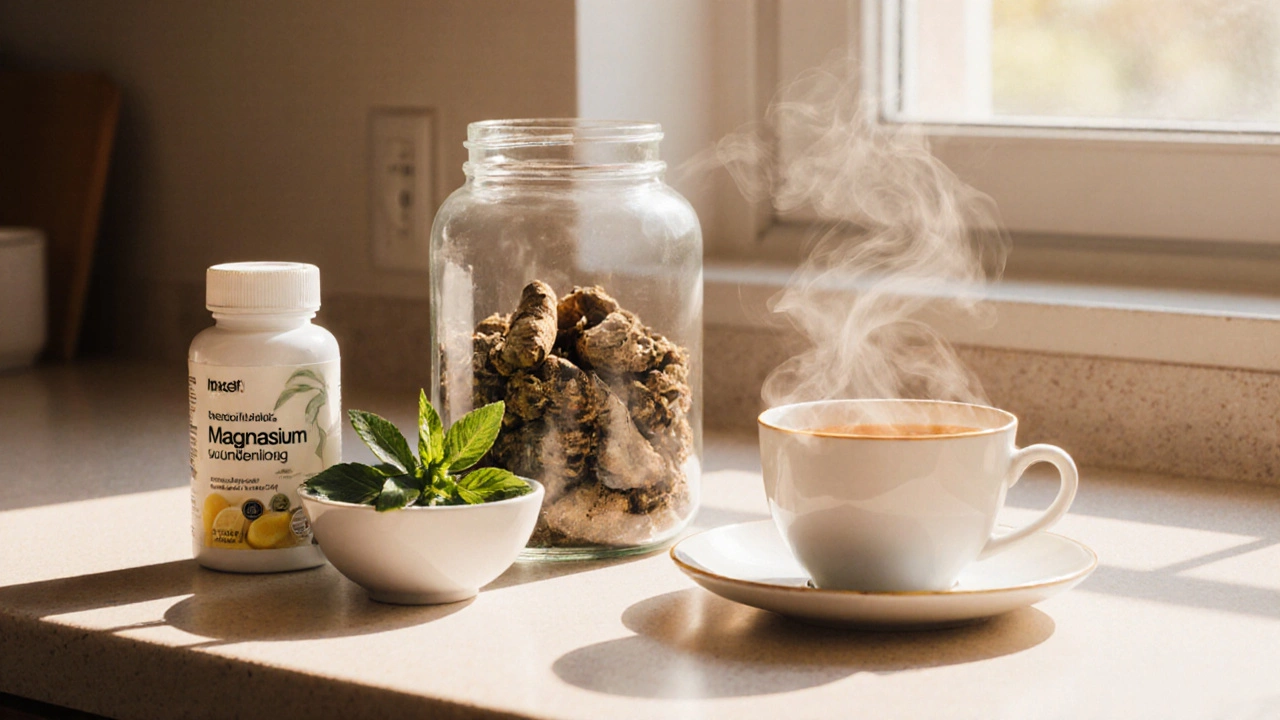
3-3-3 Rule Practice Checker
After completing the 3-3-3 rule exercise:
- Enter the three things you saw
- Enter the three textures you touched
- Enter the three sounds you heard
This tool will verify if your responses follow the proper technique and provide personalized feedback.
Your Practice Result
When anxiety erupts, you need a tool that works in seconds, doesn’t require any special equipment, and can be used anywhere. The 3-3-3 rule fits that bill perfectly-it’s a simple grounding exercise that calms the nervous system while you reach for deeper, longer‑term support like herbal supplements.
What the 3-3-3 Rule Actually Is
3-3-3 rule is a three‑step sensory grounding technique designed to shift attention from racing thoughts to the present moment. The name comes from the three things you notice, the three you touch, and the three you hear. By engaging sight, touch, and sound, you interrupt the fight‑or‑flight loop and give the brain a clear cue that you’re safe.
How to Do the 3-3-3 Rule in Real Time
- Look around and name three things you can see. Be specific - a green leaf, a blue mug, a cracked tile.
- Touch three objects and describe their texture. It could be the smooth surface of your phone, the cool metal of a spoon, or the soft fabric of your shirt.
- Listen for three distinct sounds. Maybe it’s the hum of an air‑conditioner, a distant car, or the ticking of a clock.
Each step takes only a few seconds, but together they create a mini‑mindful reset. If you’re in a crowded train, you might notice the flicker of a neon sign, the strap of your bag, and the murmur of a conversation. The key is to stay factual-no judging, just observing.
Why the 3-3-3 Rule Works: The Science in Simple Terms
Grounding techniques activate the parasympathetic nervous system, the part of the brain that tells the body to relax. By focusing on external stimuli, you reduce the amygdala’s alarm signals, lowering cortisol levels within minutes. Research from the University of California (2023) showed that participants who used a 3‑step grounding exercise reported a 30% drop in self‑rated anxiety after just one minute.
Pairing the Rule with Herbal Supplements for a Balanced Approach
While the 3-3-3 rule offers instant relief, many people turn to herbal supplements for anxiety to support the nervous system over the long term. Below are five botanical allies that blend well with the grounding practice.

Top Herbal Allies for Anxiety
| Herb | Active compound | Typical dose | Onset of effect | Evidence level (2023‑2025) |
|---|---|---|---|---|
| Ashwagandha an adaptogenic root | Withanolides | 300‑600mg daily | 1‑2 weeks | High (RCTs) |
| Lemon balm a calming herb from the mint family | Rosmarinic acid | d>300‑500mg 3×/day30‑60min | Medium (small trials) | |
| Passionflower a vine with sedative properties | Flavonoids (e.g., vitexin) | 250‑500mg daily | 45‑90min | Medium (meta‑analysis 2024) |
| Valerian root a traditional sleep aid | Valerenic acids | 400‑900mg before bed | 1‑2h | Low to Medium (mixed results) |
| Magnesium glycinate a mineral that relaxes muscles and nerves | Magnesium | 200‑400mg daily | 24‑48h | High (observational studies) |
These herbs don’t replace professional treatment, but they can lower baseline anxiety, making the 3‑3‑3 rule feel smoother and more effective.
Integrating the 3-3-3 Rule into Your Daily Routine
- Morning reset: Before checking emails, spend one minute on the rule. It sets a calm tone for the day.
- Work‑day break: When a deadline looms, step away, sip your ashwagandha‑infused tea, and run through the three senses.
- Evening wind‑down: After dinner, take a short walk, notice three things you see, feel, and hear, then take your magnesium supplement.
Pairing a brief grounding session with a daily herbal dose creates a two‑pronged strategy: immediate symptom relief plus long‑term nervous‑system balance.
Common Pitfalls and How to Avoid Them
- Rushing the steps: If you skim through the three observations, your brain may not register the shift. Slow down, name each item loudly.
- Choosing the wrong environment: A noisy, chaotic space can overwhelm your senses. Find a quiet corner or use noise‑canceling headphones if needed.
- Over‑reliance on supplements: Herbs work best when combined with lifestyle habits-sleep, exercise, and nutrition.
- Skipping dosage consistency: Herbal benefits accrue over weeks. Set a reminder to take your dose at the same time daily.
- Ignoring medical advice: If you’re on prescription meds, consult a healthcare professional before adding herbs like valerian or passionflower.

Quick Checklist: 3-3-3 Rule + Herbal Support
- Identify three visual cues.
- Touch three distinct textures.
- Listen for three separate sounds.
- Take a daily dose of a vetted herb (e.g., ashwagandha 300mg).
- Log your anxiety levels for 2 weeks to track progress.
Frequently Asked Questions
Frequently Asked Questions
Can the 3-3-3 rule be used during a panic attack?
Yes. Even if your heart races, slowing down to notice three things you see, feel, and hear can interrupt the panic loop. It’s best to start the exercise as soon as the first wave of symptoms appears.
Are there any side effects of the recommended herbs?
Most herbs are safe at standard doses, but some people experience mild drowsiness (valerian) or stomach upset (magnesium). Always start with a low dose and watch for reactions.
Do I need a therapist if I use the 3-3-3 rule?
The rule is a coping tool, not a replacement for professional care. If anxiety interferes with work, relationships, or sleep regularly, seek a mental‑health professional.
How long should I practice the 3-3-3 rule each day?
A single minute is enough for a quick reset. You can repeat it 2‑3 times a day, especially before stressful meetings or after a stressful event.
Can I combine multiple herbs together?
Yes, many formulations blend ashwagandha, lemon balm, and magnesium. However, check for interactions and keep total magnesium below 350mg from supplements to avoid diarrhea.
Next Steps: Build Your Personal Anxiety Toolkit
Start right now: glance around your room, name three items, feel three textures, listen to three sounds. Then, choose one herb from the table that fits your lifestyle-perhaps a morning ashwagandha capsule with breakfast. Track your mood for a fortnight and adjust the dosage or herb based on what feels best.
Remember, the 3‑3‑3 rule is a micro‑skill you can master in minutes, while herbal supplements act as the macro‑support that keeps your nervous system steady over weeks and months. Use both, stay consistent, and you’ll notice anxiety losing its grip.

Write a comment